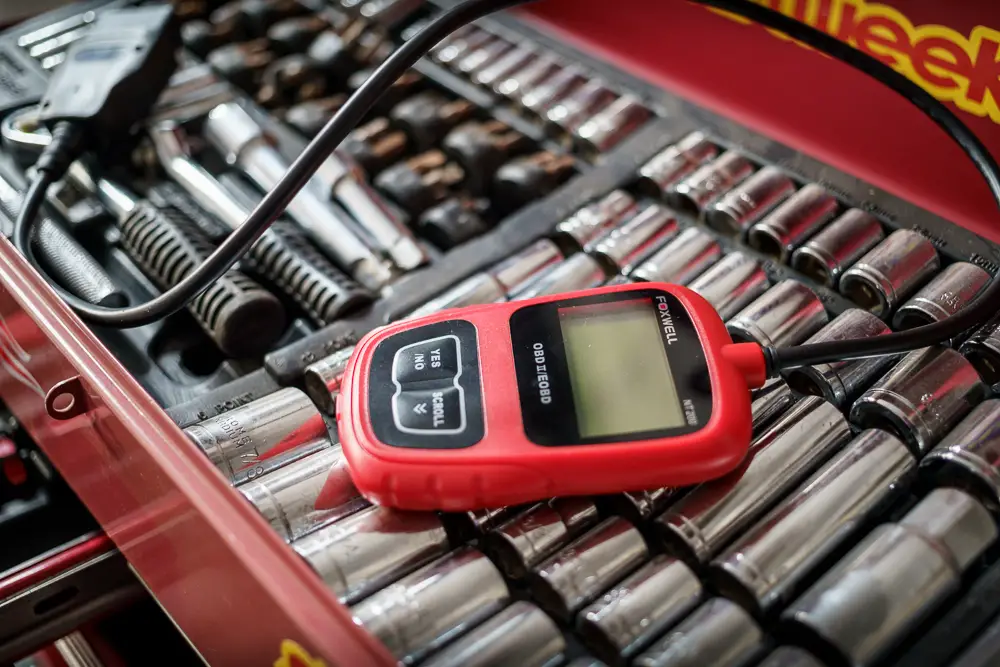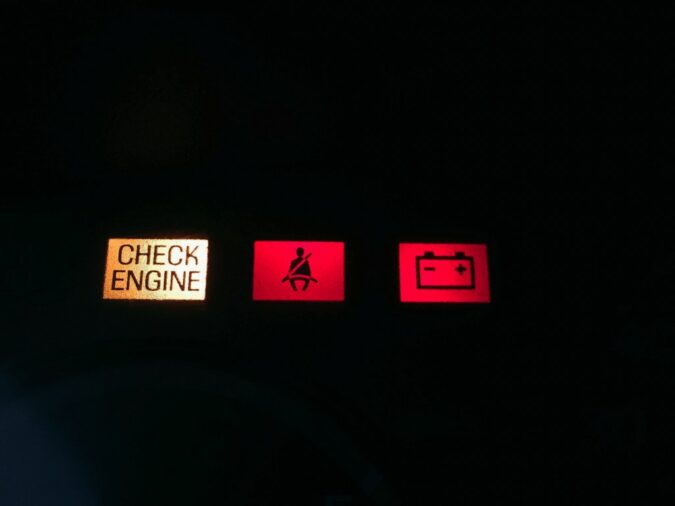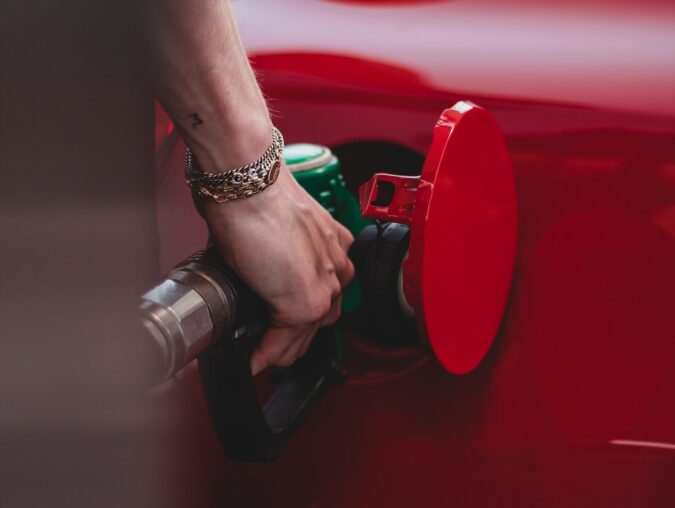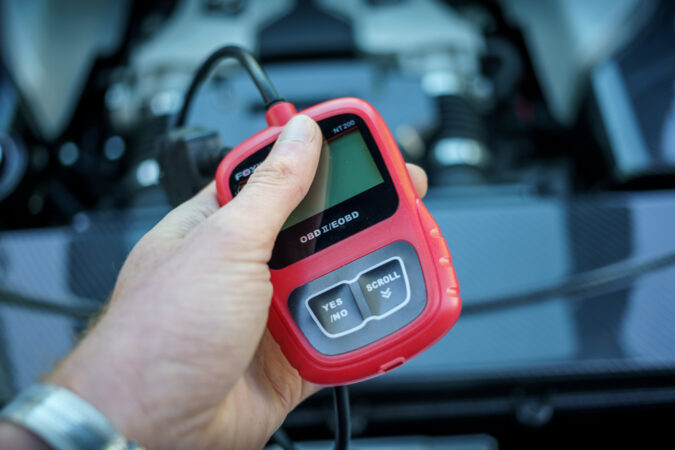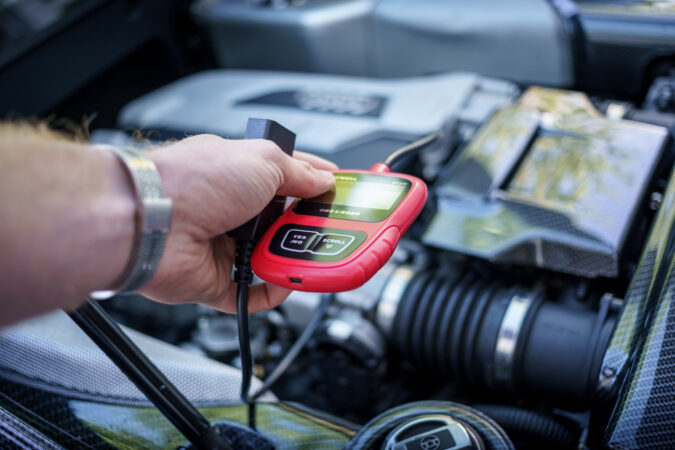P0446 is a trouble code that demands a discussion. Mechanics and car users look for more info regarding this EVAP-related trouble code. Here you can find all the answers you need on the P0446 trouble code.
An OBD II scanner is easily the most important tool a mechanic can have. It not only facilitates easy detection of hidden issues in a vehicle but also saves you a ton of time and money that diagnosis usually takes.
Trouble codes spring up with their advantages and disadvantages. They point at issues that are not easy to diagnose at one end. On the flip side, they can be the indicator of a terrible failure.
Here let us understand what P0446 stands for, what can cause it, and how to remedy it. On top of it, we will also discuss the costs related to this repair. Let us dig in.
- What Does P0446 Mean?
- Parts & Inner Working
- What Causes P0446 Code?
- Testing For EVAP System Leakage
- Cost Of Fixing
What Does P0446 Code Mean?
The P0446 is an Evaporative Emission Control (EVAP) system-related trouble code. This code is especially triggered by a failure of a vent control valve that is inside the EVAP module.
Working Of An EVAP System
The Evaporative Emission Control (EVAP) is a system that helps reduce the harmful emissions from a car, as its name suggests. Specifically speaking, the EVAP system prevents fuel vapors from entering the atmosphere.
To trap the fuel vapors, the EVAP system employs a vapor canister. This is just one among many components that work together to control the emissions output from the exhaust.
The primary aim of an EVAP system is to trap the fuel vapors and redirect them into the engine. Any leak in the system can trigger a P0446 code. To understand how this happens, we need to know the parts of an EVAP system.
Parts Of An EVAP System
Just like every vehicle system, the EVAP system consists of a myriad of parts that work together. The EVAP system of a vehicle consists of mainly three parts, the vapor canister, the purge solenoid, and the vent valve for the canister. Other parts that support the EVAP system include a pressure sensor, the fuel tank, and its fuel cap.
Let us have a closer look at each of these parts as well as the functions they play.
1. Vapor Canister
The largest component of an EVAP system is the vapor canister. Despite its size, it is seldom the cause of a P0446 code. It is a special container that traps the fuel vapors.
To attract the fuel vapors into the vapor canister, the EVAP system uses the vacuum created inside the engine. This is the route the vapors take to reach the cylinders, where they are scavenged for optimal combustion.
The EVAP system’s canister is built usually with plastic, making it withstand the test of time. The plastic construction also helps to keep corrosion at bay. Inside the vapor canister, it is filled with activated charcoal. This helps to absorb and store the vapors from the fuel tank.
As we know, any leak in the EVAP system triggers the P0446 code. But the EVAP canister is less likely to be the source of that leak. As it is not a moving part, it is not as likely to fail as some other components of the system.
But that does not mean that it is completely bulletproof. The EVAP canister can also wear over time and be the source of the leakage. But if your car is not very old, and it throws the P0446 code at you, the canister should not be the first place you look.
2. Purge Valve/Solenoid
The purge valve sits en route to the engine. This allows the fuel vapors stored in the vapor canister to flow into the engine, during the intake stroke.
Several types of purge valves are used in EVAP systems. A common type is a vacuum-operated purge valve. It can also be a solenoid, electrically operated as per the instructions from the Powertrain Control Module.
If you encounter a P0446 code, it can mean a leak in the system, or something else, which we will get to in a while. This leak can be triggered by a faulty purge valve as well. As it is a part that constantly moves, the chances of it failing are higher.
Locating the purge valve is easy. In many cars, it is located near the engine and the throttle body. In some other vehicles, it can be spotted above the vapor canister.
3. Vent Valve
Vent valves, as their name suggests, vent the additional vapor buildup inside the system. They work in a similar fashion as the purge valve but perform different functions.
In a generic EVAP system, there are two different vent valves. The first one is a canister vent valve which prevents pressure or vacuum buildup inside the fuel tank. This can be due to changes in fuel temperature or the constant movement of liquid fuel inside the tank.
The canister vent valve prevents the buildup of additional pressure inside the tank and maintains atmospheric pressure. This takes away the possibility of additional loads acting on the remaining components of the fuel system.
The second valve is a fuel tank vent valve or a rollover valve. As its second name gives away, this valve comes into action during a rollover. It prevents the flow of liquid fuel into the vapor canister in such an unfortunate event.
4. Fuel Tank And Fuel Cap
The fuel tank of a vehicle also plays an important part in the EVAP system, though it is not its main role. It stores the vapors and fuel until the vapors move into the charcoal-filled canister. The fuel tank is built with strong materials to contain the pressure or vacuum built up inside it.
The fuel cap protecting the main opening of the fuel tank needs to be strong enough to withstand the pressure inside it. Though the cap may look simple, it has a complex design that helps with this purpose. When we talk about P0446, the fuel cap is an important point of discussion.
Many instances of the P0446 code popping up arises out of a fuel cap issue so it is important to understand its role in the total system.
5. Multiple Sensors
Like any other system in a modern vehicle, several sensors are also a part of the EVAP system. The fuel tank pressure sensor is an important one among them. It sits atop the fuel tank, or the fuel pump, and constantly measures the pressure inside it.
This pressure senses any change in the tank pressure, triggering an error code. In this case, P0446. But in some cases, the sensor can also fail to trigger the code incorrectly. In this case, replacing the sensor should work.
What Causes P0446 Code?
As you have already learned, the P0446 code is triggered by a leak in the EVAP system. But is it that simple? The answer is a spectrum that ranges from a solid yes to an absolute no.
Depending upon what causes the P0446 to come up, the complexity of the repair job can vary. It may be as easy as tightening your fuel tank cap. Or it can be as hard and frustrating as a long diagnosis process and several hours to repair the issue.
Similarly, the cost for repairing the issue can also range from absolute zero to many thousands, based on what is causing this issue to crop up.
It is almost impossible to diagnose the cause of P0446 right when it starts to show. The check engine light is the primary symptom that you can see. But this can mean many things. For further diagnosis, you will have to plug in an OBD II reader. If this throws a P0446 code at you, the next order of business will be to diagnose the cause. This can be quite cumbersome as there are an array of possible defects that can cause this code to appear.
To know more about this, let us dive into the most possible issues that cause the P0446 code.
1. Loose Fuel Tank Cap
Of all the issues that trigger the P0446 code, this is the cheapest problem to fix. A fuel tank cap may look like a simple part but there is more to it than what meets the eye. The fuel tank cap is specially designed to maintain the pressure inside the fuel tank.
A leak in this system can completely throw the sensors off balance. A loss in pressure can cause this code to crop up. Hence, a loose fuel tank cap can cause a scare. Fixing this is obviously very easy. Open the fuel tank cap and fit it back properly.
If this was the issue, the engine check light should go away after a while. There you go, you solved the P0446 code-related issue for free. Normally, if the P0446 code comes up alone, without any accompanying codes, it most probably is the fuel tank cap.
But what if the fuel tank cap is broken? Over time, the material inside the cap can wear out, causing cracks. This means that the cap will be unable to hold the pressure, and the cycle repeats. Check engine light, a mini heart attack, the whole drama.
There is no free fix to this though. But it should not cost you a lot of money, as a new fuel tank cap should suffice. Lock it in, and you should be good to go.
2. Leaking Fuel Tank
Now, things get a bit more expensive. Fuel tanks are made to live a lifetime. Most modern cars have fuel tanks made out of durable plastic that should stand the test of time. But that does not mean that they are completely immune to damage.
The gas tanks can also develop cracks and start to leak. And with no surprise, this is enough to bring up the code in question. The most common way these cracks can form is by scraping the tank on a speed bump or a similar obstacle on the way.
3. EVAP System Hose Leakage Causes P0446 Code
The charcoal canister of an EVAP system is mostly located near the fuel tank. In some cars, it can be found in the engine bay. No matter where it is located, it will be connected to the fuel tank via special hoses. These hoses carry the fuel vapors to the canister.
As expected, any leakage in these hoses can mean an acquaintance with the P0446 fault code. This can be very tricky to find as the hose is long, especially in vehicles with the canister located in the engine bay.
But the most probable location for a leak to form is the ends of the hose. The ends that connect to the fuel tank and the canister can develop cracks easily. But this does not mean that the rest of the hose is built for life. It is also possible that leaks form in these areas as well.
But the very first areas you should check are the ends. If you find significant deterioration at the end, you have to take action. If there is sufficient leeway in the length of the hose, you can chop off the worn-out end and refit the hose. But if the damage is severe and your car is quite old, it is recommended to replace the hose.
4. Leakage In Charcoal Canister
Though a static part with no movement, it is also possible that the charcoal canister develops leaks. Similar to the hose and fuel tank leaks, a leak in the canister can also trigger the P0446 code.
A leak here can mean that the pressure in the entire system will be compromised. Hence, the code. If this occurs, it is necessary to understand the origin of the leak. If required, the canister must be replaced.
5. Defective Vent Control Valve
Things are getting more expensive here. The vent control valve as we know is a complex electrical component that is instrumental in keeping the pressure right inside the EVAP system. Understandably, if it fails, it is an open invitation for the P0446 code to pop up, with the company of other codes.
An electrical component like the vent control valve can fail due to a short circuit in the system. If this happens, the valve may need replacement. But before we get to that, we will need to make sure that it is the valve that is causing the issue. For this, accurate diagnosis is vital as the replacement can get expensive. You do not want to spend your dollars on an unnecessary repair.
How To Test Defective Vent Control Valve?
Repair shops usually have advanced scanners that can activate and deactivate the vent control valve. These devices can help you see if there is any defect in the system. They also throw you the defect code if it finds something fishy.
If you do not have such an advanced tool and would like to test it yourself, you can do it with simple tools as well. You can use a simple multimeter, like this one that we found on Amazon, to measure the voltage coming into the input of the valve. You should keep the ignition of your car ON (Do not start the engine) while you perform the test. Lodge the negative terminal of the multimeter in an area with proper earthing, and then test the voltage. If it reads 12V, you know that the valve is now supplied with current.
To test the valve, you can directly connect it with a 12V power source. Make sure that the ignition is turned OFF to prevent any accidents or damage. When connected properly, the valve should operate, making a distinct shutting noise. If you do not hear anything like that, then the valve may be defective.
Conducting these tests will help you replace the right component. If you are relying on a garage to replace it, you can go into the job confidently with a clear idea about what went wrong.
Here is a video that explains this process in detail for you to carry out.
6. Defective Pressure Sensor
The entire EVAP system needs proper pressure maintained inside it. Any leak or a drop in the pressure can trigger the error code, P0446, or a multitude of other codes, depending on what causes it. But what if the sensor that measures this pressure goes wrong? A defective pressure sensor can output all kinds of wrong readings. This makes the ECM think that there is a leak in the system, and triggers the code.
Replacing the pressure sensor is the only fix for this issue. But just like the vent control valve, it is necessary to make sure that the sensor is the cause of the issue before you spend your dollars on a new one.
How To Test Defective Pressure Sensor?
As it is a pressure sensor, testing this requires a vacuum pump. You can pick up one of them here. You will also need a multimeter to test the voltage going into the sensor. Just like the procedure we did for the control valve testing, keep the car in the ignition and test the voltage going into the sensor.
In this case, it should be around 5V. If it is so, it shows us that the sensor is getting enough power. The next order of business is to check if the sensor responds to a change in the vacuum. For this, you will have to connect the vacuum pump as well as the multimeter. After making all connections, apply vacuum to the sensor, and see if there is a change in the voltage.
If the voltage changes according to the vacuum applied, you can make sure that the pressure sensor is working properly. Instead of spending money on the pressure sensor, you can focus on the other parts of the EVAP system.
If you need a visual guide of this entire procedure as well, here is a video we think will help.
Testing For EVAP System Leakage
The EVAP system in a car consists of several parts and many hoses that connect them. Over years, any of these can fail, and create a leakage. It is not an issue that will stop your car from working. But it can get frustrating to see the check engine light glowing at your face every time you start it.
But what if your pressure sensor is okay, your vent control valve is working properly, your fuel tank filler cap is all tight and good, and you cannot see any visible leaks? How do you inspect the other hoses and components that hide out of sight?
It is impossible to inspect all components and hoses one by one for a leak. But there is a smarter way that garages do instead. Use a smoke machine. These machines pump smoke into the EVAP system and look for any leaks that will let this smoke out through them. If there are no leaks, the smoke will be trapped inside the system and no smoke will be seen spewing out from the vehicle.
These machines can get quite expensive, though there are some cheap options. But it makes more sense for a mechanic to purchase it as it can be used to check leaks in some other systems.
Here is an experienced mechanic trying to find leaks in an EVAP system using a smoke machine.
Cost Of Fixing P0446
As we have already discussed, the repair costs to get rid of a P0446 code can vary from nothing to a lot, depending on what went wrong. Sometimes, just tightening the fuel filler cap can do the trick. Sometimes, it needs more than that, a lot more than that. Getting to the root cause of the issue can demand hours.
So, the diagnosis is a major contributor to this cost, as it can be quite tricky to spot the actual issue. It ranges from $75-$150. Only after this diagnosis, they will be able to give you an actual quote for the repair job.
With a lot of time and money lost just for the diagnosis of the P0446 code, it makes sense to DIY it. You can save some money as you can point out to the mechanic exactly what has gone wrong with your vehicle.
So, the repair job for a P0446 is a sum of the cost of the parts, and the labor cost of the specific job. The only reliable source to find out this information for your vehicle is the shop itself.
P0446 Error Code Facts:
- A P0446 error code means there is an issue with the functionality of a vehicle’s EVAP system vent valve, resulting in a malfunction in the EVAP vent control circuit.
- The EVAP system is designed to eliminate fuel vapors from entering the air and is made up of several components, including the gas tank, gas cap, charcoal canister, purge valve, and vent valve.
- The most common symptom of a P0446 error code is the illumination of the vehicle’s check engine light, and you may notice a fuel-like odor near the vehicle.
- The code may be triggered by other car problems, such as a failed charcoal canister, a clogged or damaged vent hose or filter, or a failing EVAP system pressure sensor.
- The most common causes for a P0446 code are a malfunctioning or clogged vent control valve or issues with the control circuit, such as faulty wiring.
- Issues with a vehicle’s EVAP system should not be overlooked, as they can lead to damage to other vehicle components and other similar codes appearing.
- A vehicle may still be operational with an EVAP leak, but it’s best practice to seek a qualified mechanic for repairs and diagnosis as soon as the code appears.
- Diagnosing a P0446 code accurately requires professional help from a qualified mechanic, especially if other similar codes accompany the P0446 code.
- Diagnosing and repairing a vehicle with a P0446 code requires several steps, including scanning the vehicle, checking the gas cap, performing an EVAP system leak check, and verifying the proper functioning of the vent control valve.
- More extensive diagnostic tests may be needed if the code persists even after completing these steps.

